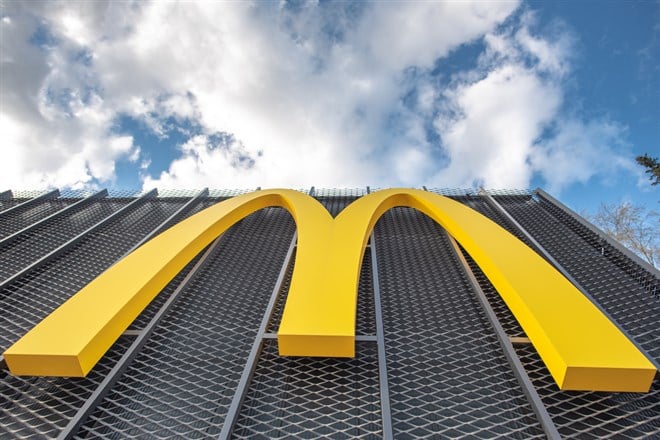
- McDonald’s continues to be able to deliver growth
- McDonald’s goes about its business ringing up sales to value-minded eaters
- McDonald’s has a steady history of quarterly dividend distributions
Far from flashy, the fast food king (sorry, Burger King) is the quintessential stable growth stock. Its brand is globally recognized and its burgers and fries have been a staple for on-the-go families and travelers for decades.
What took place more than 50 years ago was our first clue. When McDonald’s went public in April 1965, investors gobbled up shares like a 10-pack of Chicken McNuggets. A $22.50 IPO price quickly climbed to $30 by the end of the first trading day.
Nearly six decades and twelve stock splits later, ‘Mickey D’s’ is still attracting investors in search of stability. What is it that makes the stock still appetizing after all these years? Let’s dig into the bottom of the bag for that last fry to find out.
McDonald's Global Long-Term Growth…
Despite the influx of fast food and fast casual restaurant chains, McDonald’s continues to be able to deliver growth. Last year’s 53% earnings per share (EPS) growth was an anomaly tied to pandemic reopenings. But as the operating environment normalizes, Wall Street is forecasting 6% and 7% bottom line growth in 2022 and 2023 respectively. Not bad for an old school burger joint.
The reality is that many peers would love to have mid-single digit EPS growth over the next couple years as they grapple with cost inflation and slowdowns in customer traffic. It is steady growth that most find elusive because they lack the brand power and marketing prowess of a McDonald’s.
Across geographic borders, McDonald’s gets its message across about its brand and purpose. People know that they’re getting a consistent, affordable meal that’s relevant to their culture. The key is that McDonald’s doesn’t rest on its laurels; it evolves with the times.
Nowadays much of the company’s marketing strategy is digital. Through initiatives like the newly launched ‘MyMcDonald’s’ rewards program, customers are continually reminded of the value that a stop at McDonald’s represents. Within six months of its U.S. launch, some 30 million members enrolled. Yes, McDonald’s is still relevant to modern consumers—and to an increasing extent in today’s inflationary economy.
McDonald's…With a Side of Defensive
With over 40,000 locations across 100-plus countries, it's hard to go anywhere without spotting the golden arches. And when consumers' budgets get spread thin as they are now, restaurant, drive-through, and delivery volume tends to stay the same if not pick up. It is this constant source of demand that enables McDonald's to succeed in strong and weak economies alike.
As full-service restaurants struggle to fill tables during recessionary periods, McDonald’s quietly goes about its business ringing up sales to value-minded eaters. The value menu starts looking pretty tasty when gas and grocery prices rise at their fastest pace in 40 years. Bottom line: even when money is tight, McDonald’s doesn’t get cut from the budget.
Grocery stores and other fast food operators are also defensive investments, but McDonald’s belongs near the top of the list. Down about 5% year-to-date, it has held up well compared to its Dow cohorts and the broader S&P 500 index. If the stock happens to finish down for the year, it would be the first time since 2014 when it slipped 3%. Given the run it has had since, shareholders shouldn’t fret a mild (sweet and sour sauce) dip.
McDividends
In fact, even when McDonald’s has the occasional down year, its dividend payouts help soften the blow. A steady history of quarterly dividend distributions is another big reason investors are fond of the defensive stock.
Based on the forward payout ratio, roughly half of McDonald’s earnings are returned to shareholders in the form of dividends. The dividend has been increased in each of the last 45 years—and that’s in spite of the geopolitical and economic turmoil the world has endured in that span. No other restaurant can match that claim and few publicly traded companies in any industry can top it.
The current $1.38 per share income payment means that investors can collect $5.52 in annual cash handouts for every McDonald’s share owned. It's essentially a free happy meal—and represents a 2.2% forward yield that is above the consumer discretionary sector average.
Investors have gravitated towards McDonald’s shares over the last few months as the economic outlook has become more cloudy. In turn, the stock has rallied 17% off its March 2022 low and is within striking distance of its $271 all-time high.
Regardless of where the market heads in the final months of the year, McDonald’s will likely continue to catch a bid from conservative investors. If it manages to close up for the year, it’ll be only the second Dow-30 stock (UnitedHealth Group being the other) to have finished green every year since 2015.












